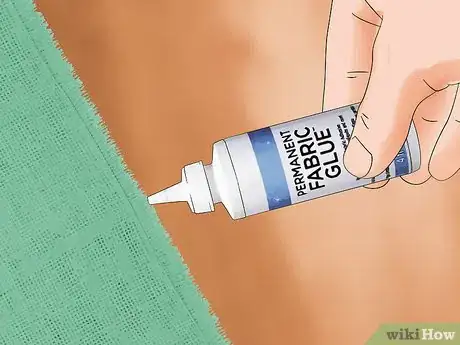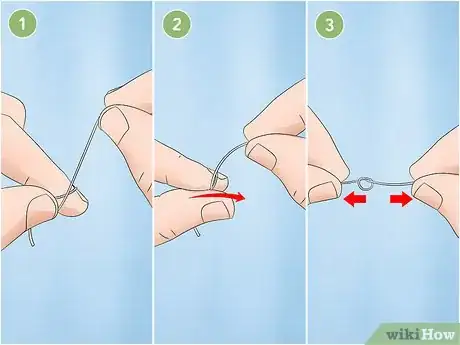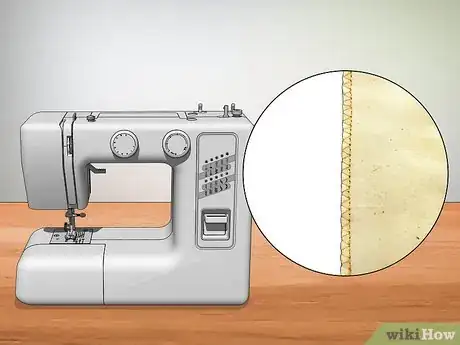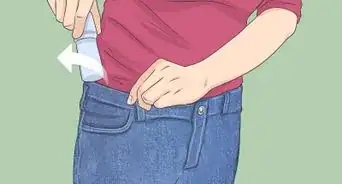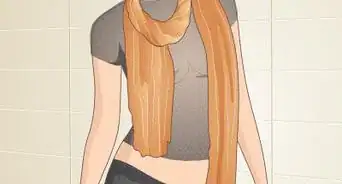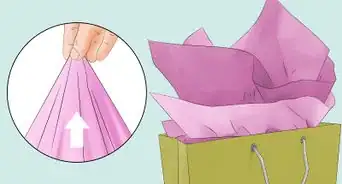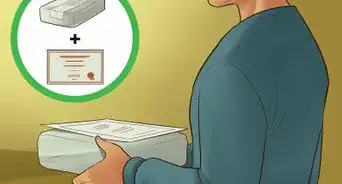This article was co-authored by Kamel Almani. Kamel Almani is a Laundry and Cleaning Specialist and the Co-Owner of WashyWash, a toxin-free and eco-friendly laundry and dry clean service based in Amman, Jordan. Kamel and his staff at WashyWash use Blue Angel certified and dermatologically-tested detergents. They also combine EcoClean and digital technology to provide an eco-friendly, convenient, and quality cleaning service. Kamel holds a BA in Design from the University of Applied Science, Amman.
There are 15 references cited in this article, which can be found at the bottom of the page.
This article has been viewed 145,516 times.
Learning how to effectively stop fabric from fraying can save you time, aggravation, and money. Whether you’re in the middle of a sewing or quilting project or you’re trying to salvage a favorite piece of clothing, a fraying edge can be an unwelcome sight. There are several methods out there that will help you preserve your fabric edges and prevent fraying.
Steps
Using No-Sew Techniques
-
1Use scotch tape for a quick fix. Lay your fabric on a hard, flat surface with the back facing up. With the fabric’s edge laid out in front of you horizontally, place the tape along the top of the edge. Cover about 1⁄2 in (1.3 cm) of the fabric’s edge with the tape. Let the excess tape fix the fabric loosely to your work surface. Cut a new, clean line through the taped fabric, below the fraying edge.[1]
- Leave the tape on the edge to keep it from fraying.
- Scotch tape is a clear, adhesive tape. Select a matte tape as opposed to one with a glossy finish because it will be less noticeable.
- This method will not last if the piece is washed, but it is helpful when cutting straight edges in hard-to-handle fabrics. It is also useful for pillows or other projects where the seams are hidden and subject to minimal washing.
-
2Glue your edges with fabric glue, seam sealant, or super glue. Purchase any one of these adhesives at a local craft store or online. Simply place small dabs of glue along the edge of the fabric. Use a cotton swab or toothpick to spread the glue evenly. Avoid using too much glue as it can leave dark spots on your fabric once it has dried.[2]
- Alternatively, use the same process to apply the glue but then fold the glue-covered edge of the fabric over and press it down to create a hem.
Advertisement -
3Using pinking shears to cut a fresh edge. Pinking shears look like scissors with teeth and you can find them at any craft store or online. You use them as you would use scissors, cutting a new edge onto your fabric. Instead of a straight edge, however, the shears cut in a jagged-tooth pattern. This cut will prevent the edges from fraying.[3]
- This is a popular beginner-level method for dealing with fraying edges.
- For additional stability, apply adhesive to the cut edge with a cotton swab or toothpick.
Hand-Stitching the Edge
-
1Cut and tie your thread. The low-tech and old-fashioned way to deal with a fraying edge is to fix it with a needle and thread. To begin, cut a length of thread that is around 18 in (46 cm) in length. Tie a knot in one end by looping the end around your forefinger, then push the shorter end through the loop, and pull it through.
-
2Thread your needle. Take the unknotted end of your thread and grasp it between your thumb and forefinger. Loop it around the needle and slip the tiny loop off over the head of the needle creating a tight little loop. Flatten the loop between your fingers and then insert it through the eye of the needle until the loop pokes out the other side. Grasp the loop with your fingers and pull it through until the tail comes through.[4]
- You may need to cut a fresh end on your thread if it is a bit worn and floppy, as a soft piece of thread is difficult to work with.
- Pull the tail through so that it is about 3–4 in (7.6–10.2 cm) in length.
-
3Insert the needle from back to front to create a whipstitch.[5] Hold your fabric with the front or finished side facing up. Starting at the back of the fabric, insert the needle as close to the edge as you can. Push the needle through the fabric to the front and pull the thread through until the knot catches.[6]
- Don’t pull too tightly or you’ll create a rumpled look on your edge.
- Stay close to the edge, about 1⁄8 in (0.32 cm) or less is ideal.
-
4Repeat your stitch to finish the edge. Place your needle again on the back of the fabric, next to the spot where you inserted it for your first stitch. Move on, repeating this same stitch across the length of your edge, always inserting the needle from the back to the front.[7]
- Space your stitches closer together for a tighter stitch or farther apart for a looser stitch.
-
5Tie off the thread after the last stitch. Turn to the back of the fabric. Thread your needle under the last stitch and pull the thread under it until a small loop forms. Pull the needled through the loop and pull to create a knot. For more security, repeat this to make a second knot.[8]
- Cut the thread to finish the edge, leaving no more than an 1⁄8 in (0.32 cm) remaining at the end.
Using a Sewing Machine
-
1Use a serger to secure the edge. The most professional way to finish an edge is with a specialized sewing machine called a serger.[9] This sewing gadget uses four threads and two needles. Thread your serger and feed your seam under the foot, moving it through your machine needles, as you would with any sewing machine.[10]
- Be careful to remove pins before feeding the fabric through the serger.
- A serger sews, cuts, and finishes a seam all at the same time. For this reason, it can save you time.
- A serger is a specialized machine that cannot replace all the more basic functions of a regular sewing machine. They cost a couple hundred dollars, but if you do a lot of finishing work this might be a good choice for you.
-
2Try a zigzag stitch on your sewing machine. Set your sewing machine to the zigzag setting by using the dial or digital display on its side.[11] Place the fabric under the raised foot of your machine.[12] Lower the foot and proceed to feed the fabric through the machine. Keep the fabric’s edge lined up with the middle of the foot.[13]
- Refer to your machine’s manual for details if you’re unsure how to set it for a zigzag stitch.
- Add a few reverse stitches at the beginning and end to knot the thread.
-
3Use an overlock foot and your sewing machine to mimic a serger stitch. Remove the regular foot of your machine and attach the overlock foot in its place.[14] Set your machine to do an overlocking stitch. Line your fabric up with the inner edge of the foot. Feed the fabric through the machine as usual.
- By attaching an overlock foot to your sewing machine you can create a stitch that looks similar to what a serger creates.
- Use a zigzag setting with the overlock foot to achieve a similar finishing effect if you don’t have an overlock setting on your machine.[15]
- Consult your sewing machine manual for details on switching out the foot. It is usually a matter of popping it off and on, no tools required.[16]
Expert Q&A
-
QuestionHow do I keep my delicate clothes from getting frayed when I wash them?
 Kamel AlmaniKamel Almani is a Laundry and Cleaning Specialist and the Co-Owner of WashyWash, a toxin-free and eco-friendly laundry and dry clean service based in Amman, Jordan. Kamel and his staff at WashyWash use Blue Angel certified and dermatologically-tested detergents. They also combine EcoClean and digital technology to provide an eco-friendly, convenient, and quality cleaning service. Kamel holds a BA in Design from the University of Applied Science, Amman.
Kamel AlmaniKamel Almani is a Laundry and Cleaning Specialist and the Co-Owner of WashyWash, a toxin-free and eco-friendly laundry and dry clean service based in Amman, Jordan. Kamel and his staff at WashyWash use Blue Angel certified and dermatologically-tested detergents. They also combine EcoClean and digital technology to provide an eco-friendly, convenient, and quality cleaning service. Kamel holds a BA in Design from the University of Applied Science, Amman.
Laundry & Cleaning Specialist Put them in a mesh bag before you wash them. Then, use a gentle cycle wash with a low spin, and hang them to dry—don't use a dryer.
Put them in a mesh bag before you wash them. Then, use a gentle cycle wash with a low spin, and hang them to dry—don't use a dryer. -
QuestionHow do you stop fabric from fraying with nail polish?
 wikiHow Staff EditorThis answer was written by one of our trained team of researchers who validated it for accuracy and comprehensiveness.
wikiHow Staff EditorThis answer was written by one of our trained team of researchers who validated it for accuracy and comprehensiveness.
Staff Answer wikiHow Staff EditorStaff AnswerCut off the frayed edge, then paint some clear nail polish along the edge. Let the polish dry completely before you handle the edge of the fabric. Be careful not to make it too thick, since this will stiffen the edge of the cloth. You might need to touch up the polish after a while as it begins to flake off.
wikiHow Staff EditorStaff AnswerCut off the frayed edge, then paint some clear nail polish along the edge. Let the polish dry completely before you handle the edge of the fabric. Be careful not to make it too thick, since this will stiffen the edge of the cloth. You might need to touch up the polish after a while as it begins to flake off. -
QuestionHow do you stop elastic from fraying?
 wikiHow Staff EditorThis answer was written by one of our trained team of researchers who validated it for accuracy and comprehensiveness.
wikiHow Staff EditorThis answer was written by one of our trained team of researchers who validated it for accuracy and comprehensiveness.
Staff Answer wikiHow Staff EditorStaff AnswerYou can use a liquid fabric stabilizer, or stabilize it with a zigzag stitch. You can do the zigzag stitch either by hand or with a sewing machine.
wikiHow Staff EditorStaff AnswerYou can use a liquid fabric stabilizer, or stabilize it with a zigzag stitch. You can do the zigzag stitch either by hand or with a sewing machine.
Things You’ll Need
Finishing Without Sewing
- Scotch tape
- Scissors
- Fabric glue, seam sealant, or super glue
- Pinking shears
Hand-Stitching the Edge
- Sewing needle
- Thread
- Scissors
Using a Sewing Machine
- Serger or sewing machine
- Thread
- Scissors
- Overlock foot (if using the overlock stitch)
References
- ↑ https://youtu.be/g84e7NIqbIQ?t=6
- ↑ https://ourpastimes.com/keep-fabric-fraying-sewing-superglue-12076023.html
- ↑ https://youtu.be/v6uPOFDf8YU?t=37
- ↑ https://youtu.be/S6u173Ap2mc?t=52
- ↑ https://youtu.be/EAykcosWod4?t=65
- ↑ https://sewguide.com/sew-overcast-stitch-machine-hand/
- ↑ https://sewguide.com/sew-overcast-stitch-machine-hand/
- ↑ https://youtu.be/f58woIqfz3o?t=1
- ↑ https://youtu.be/Onf2VvjuWIo?t=17

